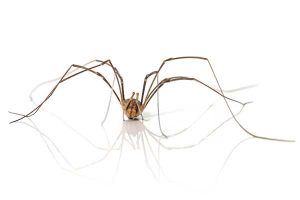The most persistent myth surrounding “daddy longlegs” is that they are the world’s most venomous spider and we’re only safe from their bite, we are told, because their fangs are too small and weak to break through human skin.
It turns out that the notion is false on both counts. But a little clarification is needed.
In order to understand this notion, it first must be determined what a Daddy Longlegs is. According to Wikipedia, Daddy Longlegs can be referred to as any one of the following:
- Opillones – these are an order of arachnids, more commonly known as Harvestmen
- Pholcidae – an order of spiders more commonly known as Cellar Spiders
- Crane Fly – a member of the family of insects in the order of Diptera
Daddy Longlegs is just a nickname, so let’s get scientific
As we can see from above, Daddy Longlegs is just a nickname, and can include any one of the above insects, so to understand if Daddy Longlegs are indeed dangerous, we should look at each insect separately to determine the answer to this question.
Opillones – Harvestmen
Harvestmen can be found on every contentment in the world, excluding Antarctica. There have been over 6,500 different documented species of Harvestmen worldwide, and the true number of different species is thought to exceed 10,000. Harvestmen have been documented as far back as 400 million years through various fossils, which shows their basic body structure has changed very little since then.
Are Harvestmen venomous?
In short the answer to this question is no. This is a fable that has spread, which states a Harvestmen’s fangs are too short, or too frail to pierce a humans skin, and if these fangs were able to pierce the skin, their venom would be among the most dangerous in the world. Of all the different species of Harvestmen researched, not one of them has venom glands. Harvestmen also do not have hollow fangs to transmit venom, instead Harvestmen use their fangs as grasping claws.
Pholcidae – Cellar Spiders
Pholcidae, often referred to as Cellar Spiders as also commonly known as Daddy Longlegs. Spiders from this family are fragile, and a range in body size from 2 to 10 mm. Their body can differ in shape depending on the group they belong to. Legs on these spiders have been documented up to 50mm in length.
Are Cellar Spiders venomous?
Cellar Spiders are spiders, so yes they are venomous. The real question should be: is the venom toxic enough to affect a human, and what kind of reaction would it produce when compared to other venomous spiders?
In 2004, the Discovery Channel’s television series, Myth Busters aired an episode that tested the urban legend of the Cellar Spiders venom. In this episode, Adam Savage stuck his hand in a container of Cellar Spiders, and noted that he felt a bite that produced a short lived burning sensation, but nothing else. It was also noted during the episode that these spiders’ fangs measured approximately 0.25mm in length, while the average human skin thickness ranges between 0.5 to 4mm in thickness.
Crane Flies
Crane flies resemble an oversized mosquito and are found worldwide. Crane flies are often referred to a Mosquito Hawks, Mosquito Eaters, Gallnipper, and Gollywhoppers. They sometimes are also referred to as Daddy Longlegs, because of their long legged appearance.
Are Crane Flies Venomous?
No they’re not, Crane Flies are an invasive flying insect, not a spider. Crane fly larvae live in the top layers of soil where they feed on roots, root hairs, and crops. The larvae can harm the growth of everything from normal lawns, to agricultural crops. Other than agricultural losses and damage to ornamental landscape plants, crane flies pose no threat to humans.
